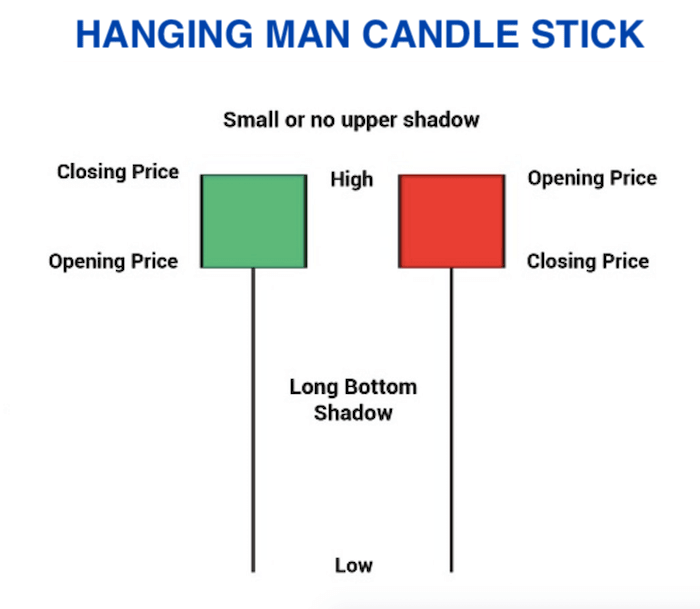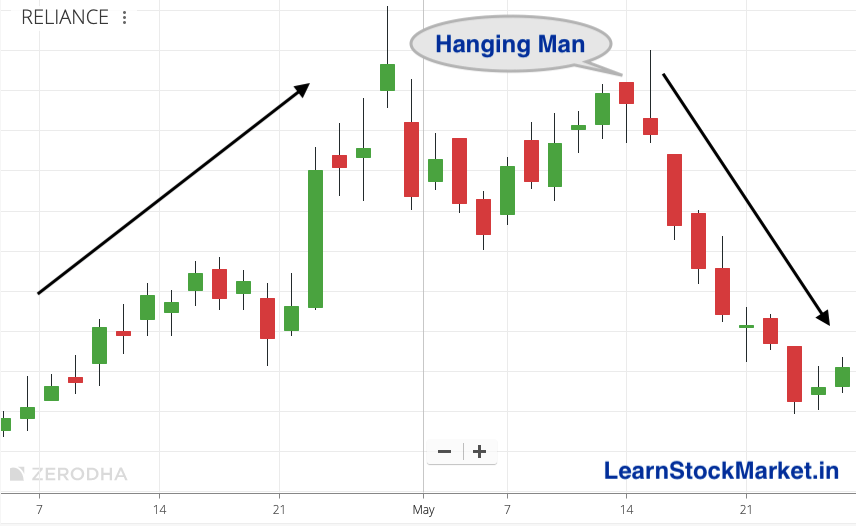‘Hanging Man’ candle is similar to the ‘Hammer‘ in shape, but when it appears during an uptrend it’s called ‘Hanging Man’.
Both ‘Hammer’ and ‘Hanging Man’ are trend-reversal candles.
The ‘Hanging Man’ candle forms when the price moves significantly lower than its opening price. After hitting a low, the price rises drastically to close slightly above or just below its opening.
The ‘Hanging Man’ candle can be either green or red. Ideally, the tail or wick of the candle should be twice the size of the body.

Psychology of Hanging Man Candle
As you read the next two paragraphs, try to visualise why the Hanging Man candle gets formed.
A stock has been on an uptrend for the last 3 months. The price has risen steadily. One day, you see the price falling heavily (due to selling pressure). But the price recovers to end slightly above or below the opening.
In other words, the bears (sellers) tried to take control and bring the price down. But the bulls (buyers) resisted the fall and took the price back up. That’s how the ‘Hanging Man’ candle gets formed.
The ‘Hanging Man’ can be one of the first signs of weakness during an upward trend. It could happen because of ‘profit booking’ or ‘expensive valuations’. But in purely technical terms, it’s a sign of weakness for the stock.
If the exact same candle gets formed during a downtrend, it’s called a ‘Hammer’ and it could potentially reverse the downtrend and take the stock upwards.
How traders use ‘Hanging Man’ Candle
If the previous few candles were moving upwards and a ‘Hanging Man’ candle is formed, it’s considered to be a sign of topping out.
Traders wait for the next candle to confirm a possible change in trend. If the next candle after the ‘Hanging Man’ closes below the closing price, then the trend reversal is partially confirmed.
By itself, the ‘Hanging Man’ does not confirm a trend reversal. When it’s used in combination with trend lines and other technical indicators, a trend reversal can be confirmed with more certainty.
Do note, a stop loss is an absolute must for every trade you take.
Examples of Hanging Man on Charts

In the chart above, Reliance Industries was in an uptrend. The stock had risen significantly over a short period of time. There was weakness in between, but the ‘Hanging Man’ candle resulted in a sharp downfall.
The short term trend reversal for Reliance was confirmed when the candle next to the ‘Hanging Man’ was also bearish.
Hanging Man for Long Term Investors
If a stock has risen way too much in a short period of time, investors can look for ‘Hanging Man’ candles to book full or partial profits.
Candles like ‘Hanging Man’ can be used in combination with Fundamental Analysis. If the price-to-earning ratio (P.E) is too high and the stock is showing bearish signs on the chart, profits can be booked.
However, selling your winning stocks after a single bearish candle isn’t the right approach.
Long term investors can only make large gains by holding on to winners for a long period of time – until the trend reversal is confirmed on weekly or monthly charts. Daily charts and lower (60 min time frame etc) are for short to medium term traders only.
Good stocks in an uptrend should not be sold due to short-term weakness on the charts.


Good Explanation
First of all. Thanks very much. Please post more content regarding candlestick patterns and technical anlaysis. As the language used here is easy to understand and simple. We always immediately see such pattern form in a current market uptrend and downtrend move.